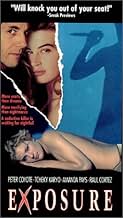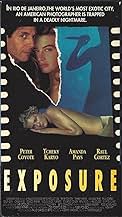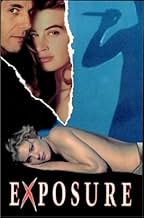Um fotógrafo americano no Rio de Janeiro se envolve no mundo da "cultura da faca" quando decide encontrar o assassino de uma de suas modelos.Um fotógrafo americano no Rio de Janeiro se envolve no mundo da "cultura da faca" quando decide encontrar o assassino de uma de suas modelos.Um fotógrafo americano no Rio de Janeiro se envolve no mundo da "cultura da faca" quando decide encontrar o assassino de uma de suas modelos.
- Direção
- Roteiristas
- Artistas
- Prêmios
- 4 vitórias no total
Tchéky Karyo
- Hermes
- (as Tcheky Karyo)
José René Ruiz
- José Zakkai - Iron Nose
- (as Rene Ruiz)
Miguel Ángel Fuentes
- Camilo Fuentes
- (as Miguel Angel Fuentes)
Cássia Kis
- Mercedes
- (as Cassia Kiss)
Alvaro Freire
- Evilásio - Mitry's Butler
- (as Álvaro Freire)
Avaliações em destaque
This is a well made, low key thriller about knife fighters in Rio. Peter Coyote gives one of his best performances. The only quibble I had with the film is that I wanted to see A WHOLE LOT MORE KNIFE FIGHTING!
After all that great, cool set up and the main character undergoing the Art of Knife Fighting training. I was a bit disappointed we didn't get many more knife fights. This could have been the ultimate knife fighting movie. Still, it's good. But when during the final fight sequence I wanted something more spectacular, blood spraying to the heavens like the end of Kurosawa's Sanjuro. And after seeing the extraordinary knife fighting sequence in Kill Bill I was expecting a little more.
After all that great, cool set up and the main character undergoing the Art of Knife Fighting training. I was a bit disappointed we didn't get many more knife fights. This could have been the ultimate knife fighting movie. Still, it's good. But when during the final fight sequence I wanted something more spectacular, blood spraying to the heavens like the end of Kurosawa's Sanjuro. And after seeing the extraordinary knife fighting sequence in Kill Bill I was expecting a little more.
10jazz2004
Whoever owns this movie please release on DVD. This is a cult type movie centered around knife fighting. The back story, cinematography, and allure of a dangerous earthly South America draws the viewer into what is probably Peter Coyote's most interesting work. Highly recommended! Very few movies transmit the feeling of a place as well as this movie does so visually. I have been searching for this movie for sometime and wonder why it hasn't been released on DVD. Early Walter Salles is much better than most of what is being shot today. Coyote plays a photographer living in Rio that avenges the death of a prostitute friend and goes on a journey through South America to do so. In the process of this his character learns to fight with knifes and becomes involved in an underworld whose rules he is forced to adapt to and survive.
A film that is extremely evocative - so many exciting nuances. It is unforgettable - a pity that the actor who played the "knife expert" is seen more. One of Peter Coyote's best.An unusual cast - many contrasts. The photography is outstanding. A haunting experience....
10scvanv
Fighting with edged weapons fell into obscurity after the advent of the gun. The old European blade skills almost died out, as did the Oriental arts of Arnis, Escrima, and Silat(which were derived in part from the fighting art of the Spanish Conquistadors).
The science of blade fighting smoldered weakly for five hundred years in remote outposts of Indonesia, the Philippines and Japan where the gun never quite captured the imagination of peoples who had truly understood steel.
Recently, for reasons which are still obscure, blade skills have enjoyed a renaissance as a legitimate martial art in the United States. A sub-culture of knife fighting students has emerged which will be the audience of this excellent movie.
This film stands almost alone as an artistic representation of training and fighting with edged weapons. Early in the movie Tcheky Karyo carries off a chilling and realistic knife-fighting sequence which makes the hair stand up on the neck. He then plays the instructor, showing the viewer the simple beauty of how an art thousands of years old can be transmitted.
Peter Coyote makes us see the mental and physical journey of the student. At the climax of the movie he manages to project truly the mind-set needed to face steel with steel as he goes toe-to-toe with the true master in a duel to the death.
The training sequences in this movie are clear expressions of real techniques used in the old arts of Arnis and Escrima, with elements of European blade practice thrown in. The film could actually be studied as a training aid.
A certain amount of "Hollywood" was included to extend the final fighting sequence for dramatic effect, but this will not be noticed by the novice and should not interfere with the enjoyment of any viewer interested in the arts involved.
This film is an example of the movie being better than the book. Rubim Fonseca's book "The High Art" contained only the germ of the grim plot which the movie fully exploits. For some reason, after having his character learn the high art, Fonseca has him put the knife away in a drawer and back away from the brutal reality of the science he has learned, contenting himself with amorous conquests rather than the quest for vengeance which was the real core of the book.
This movie will have a limited but loyal audience for many years. It is sad that there will probably never be a DVD version in which the frames could be stopped to better understand the science involved.
The science of blade fighting smoldered weakly for five hundred years in remote outposts of Indonesia, the Philippines and Japan where the gun never quite captured the imagination of peoples who had truly understood steel.
Recently, for reasons which are still obscure, blade skills have enjoyed a renaissance as a legitimate martial art in the United States. A sub-culture of knife fighting students has emerged which will be the audience of this excellent movie.
This film stands almost alone as an artistic representation of training and fighting with edged weapons. Early in the movie Tcheky Karyo carries off a chilling and realistic knife-fighting sequence which makes the hair stand up on the neck. He then plays the instructor, showing the viewer the simple beauty of how an art thousands of years old can be transmitted.
Peter Coyote makes us see the mental and physical journey of the student. At the climax of the movie he manages to project truly the mind-set needed to face steel with steel as he goes toe-to-toe with the true master in a duel to the death.
The training sequences in this movie are clear expressions of real techniques used in the old arts of Arnis and Escrima, with elements of European blade practice thrown in. The film could actually be studied as a training aid.
A certain amount of "Hollywood" was included to extend the final fighting sequence for dramatic effect, but this will not be noticed by the novice and should not interfere with the enjoyment of any viewer interested in the arts involved.
This film is an example of the movie being better than the book. Rubim Fonseca's book "The High Art" contained only the germ of the grim plot which the movie fully exploits. For some reason, after having his character learn the high art, Fonseca has him put the knife away in a drawer and back away from the brutal reality of the science he has learned, contenting himself with amorous conquests rather than the quest for vengeance which was the real core of the book.
This movie will have a limited but loyal audience for many years. It is sad that there will probably never be a DVD version in which the frames could be stopped to better understand the science involved.
The first scene of the film is brilliant!!!! A hooker is murdered. One reporter, his friend, decide to try to find her murderer and finds a lot of different friends, places, situations that weren't expected. Specially, a "master" of knives..... Script, scenarios, photography are perfect and make a perfect match.
Você sabia?
- CuriosidadesFeature directorial debut for documentary filmmaker Walter Salles Jr.
- Erros de gravaçãoThe knife dealer says the Applegate-Fairbairn knife is used by British commandos. Actually the knife is a redesign of the Fairbairn-Sykes fighting knife that was widely used in WWII, the Applegate-Fairbairn wasn't issued to any armed forces to this day.
- Citações
Peter Mandrake: All my life, I've been looking for something... different.
- Versões alternativasUK versions are cut by 19 seconds for an '18' rating.
- ConexõesFeatured in Logotipo de Todo o Mundo: United States of America (aka 'Murica) (2016)
- Trilhas sonorasThe Photographer (A Gentleman's Honor)
Written and Arranged by Philip Glass
Orchestra conducted by Michael Riesman
Courtesy of CBS Records
Principais escolhas
Faça login para avaliar e ver a lista de recomendações personalizadas
- How long is A Grande Arte?Fornecido pela Alexa
Detalhes
Bilheteria
- Faturamento bruto nos EUA e Canadá
- US$ 356.825
- Tempo de duração1 hora 44 minutos
- Cor
- Mixagem de som
- Proporção
- 1.85 : 1
Contribua para esta página
Sugerir uma alteração ou adicionar conteúdo ausente





























